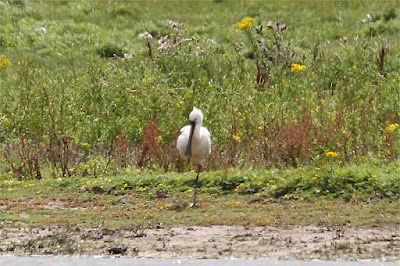 |
| Cormorant, Latchford Locks |
I've not been enjoying the birdwatching this week, perhaps down to a combination of the weather and the usual midsummer doldrums. As usual my reaction to this is to put pressure on myself to do something about it and my reaction to that is that I'm trying to make sure I don't turn this pastime into a job and so on and so on… Which is how I spent a sunny morning prevaricating as to what/where/if I was doing with it. One problem with working to public transport timetables is that when the moment comes where you've keyed yourself to set off there's half an hour, or an hour, or two hours to wait and the moment passes. And so it was looking to be today. I dragged myself out of the house, got the next train out and only decided where I was going when I bought the ticket from the guard (one of the advantages of not having a ticket machine at our station).
Which is a long-winded way of saying: I decided to go over to Padgate, walk through Woolston Eyes and get the bus home from Grappenhall.
 |
| One of the kids, a young cock sparrow |
I waved goodbye to the swarm of spadgers dividing their time between having a bath and devastating the bird feeders in the back garden (again: a pack of fat balls lasts a day and a half). The blue tits and great tits were lending a hand but the young sparrows didn't need much encouragement. We seem to have had an emergence of holly blues, too, they've been very thin on the ground the past few weeks.
I got off the train at Padgate, had a look at the buzzard circling low over the station and walked down Green Lane into Paddington. The walk along Birchwood Brook was fairly quiet of birds, aside from the woodpigeons there were only a few blackbirds feeding along the paths. There were plenty of squeaks, wheezes and ticking in the undergrowth but the robins, chiffchaffs, dunnocks and great tits involved weren't for being seen. There were a few holly blues skittering about the hedgerows here, too.
 |
| New Cut Canal |
I walked down the path along the New Cut. Blackbirds, wrens and dunnocks rummaged around the path margins and the occasional robin darted between bushes. A couple of families of long-tailed tits bounced through the treetops as I passed the pool called Grey Mist. A couple of pairs of coots fussed about the water lilies and a mallard flew in, I spent a few minutes scanning round but dragonfly came there none.
 |
| Looking over to Grey Mist |
Carrying on down I bumped into the first mixed tit flock of the day: a family of long-tailed tits with a few blue tits and a couple of juvenile chiffchaffs. There were a lot of butterflies, besides the pretty well ubiquitous large whites they were mostly woodland edge specialists: speckled woods, gatekeepers, commas, and holly blues. Beyond bridge lane the trees thin out on one side as back gardens replace builders' yards and peacocks and red admirals joined the crowds. A couple of brown hawkers patrolled the stands of Himalayan balsam.
 |
| Himalayan balsam, New Cut Canal |
 |
| Pochards, Woolston Locks |
 |
| Gadwall, Woolston Locks |
The river at Woolston Locks was busy with ducks. Upstream of the locks mute swans cruised about, mallards dozed in the reeds and family parties of pochards and tufted ducks drifted about. Downstream of the locks great crested grebes, tufted ducks and coots drifted in the waters by bend where the river branches out while gadwalls and mallards dozed and preened. A pair of shovelers lurking in the reeds on the far side of the river was a nice find.
 |
| River Mersey, Woolston Eyes |
I followed the path as it traced the course of the river round Woolston Eyes nature reserve. At this time of year the height of the bank and the depth of the trees on it means you can't often actually see the river very often. The trees were noisy with the squeaks of chiffchaffs, reed buntings and chaffinches, the wheezes of bullfinches and the twittering of goldfinches.
 |
| Gatekeeper, Woolston Eyes |
A couple of sand martins hawked over the bushes on the rise next to No.3 Bed. Cormorants, woodpigeons and magpies flew to and fro and a flock of lesser black-backs was taking advantage of flying ant day. A dark, medium-sized dragonfly zipping round the oak trees was my first migrant hawker of the year. Here on the ground I added a pile of mosquito bites to hands that had already been peppered by midges and horseflies earlier in the week.
As the path turned to follow the bank of the Ship Canal I bumped into another mixed tit flock, this one including a family party of chiffchaffs and a couple of goldfinches. I added to my already extensive portfolio of "There was a warbler there a moment ago" photographs. Herons loafed on the far bank of the canal, mute swans and mallards drifted about and a flock of swallows swooped and hawked over the treetops. At Latchford Locks a cormorant was too intent on drying out it's feathers to bother about passersby.
I didn't have long to wait for the Cat5 bus to Sale and thence home. I missed the worst of the rain, we passed through it in Partington.
 |
| River Mersey, Woolston Locks |




















































